News
Solar Panels Uplift Farmers' Income
KUALA LUMPUR, Sept 12 (Bernama) -- The solar power station of Junma, which literally means horse in Chinese, is part of the "great photovoltaic wall", an ambitious solar energy desert reclamation project, stretching along the northern edge of the Kubuqi Desert and south of the Yellow River.
Spanning about 400 kilometres (km) in length and averaging five kms in width, upon completion, this solar marvel is set to have an installed capacity of 100 million kilowatts, according to a statement.
Ordos forestry and grassland bureau deputy director, Liu Tianyun said that by 2030, the "great photovoltaic wall" project will provide 50,000 stable jobs, increase average income per capita by over 20,000 Chinese yuan annually, and boost the annual output of the ecological industry by one billion Chinese yuan. (100 Chinese yuan = RM60.85)
The benefits of solar-powered desert reclamation are substantial. The panels cut groundwater evaporation by 20 to 30 per cent, provide shade, and reduce wind speeds, all of which support plant growth.
This helps vegetation, like forage grasses that help combat dust and sand, thrive. In arid areas, integrating solar-powered water pumps with drip irrigation has proven to be an effective method for greening desert landscapes.
The "photovoltaic power generation plus desert reclamation" model, where solar panels generate clean energy above while plants and livestock thrive below is also opening new income opportunities and transforming local livelihoods.
Locals are finding various ways to boost their income, such as leasing their desertified land, participating in project construction, and engaging in contract farming. New energy and ecological management companies are encouraged to hire local farmers and herders during both the construction and operation phases.
Solar energy desert reclamation projects typically feature a protective forest system established around the photovoltaic power station, combining grass grid sand barriers with sand-fixing flora to better keep the shifting sands in check.
The city of Ordos, with vast sunflower fields, previously faced challenges with disposing of post-harvest straw. Inner Mongolia Three Gorges Mengneng Energy Co Ltd, developer of the Kubuqi Desert Ordos Central-Northern New Energy Base project, has turned this challenge into an opportunity by using the straw to build sand barriers as part of their solar-powered desertification efforts.
Each year, the company buys large quantities of sunflower straw from local farmers, using it to combat desertification, whereby this eco-friendly solution also provides an additional income stream for the local farming community.
-- BERNAMA
Other News
Sarawak Lepasi Sasaran Kapasiti Gabungan Tenaga Boleh Baharu Tahun Ini - Abang Johari

Oleh Nur Ashikin Abdul Aziz
SINGAPURA, 21 Okt (Bernama) -- Sarawak mencapai 62 peratus sasaran campuran kapasiti tenaga boleh baharu (TBB) tahun ini, melepasi sasaran 60 peratus yang digariskan dalam Strategi Pembangunan Pasca COVID-19 (PCDS) 2030.
Sarawak Pacu Pertumbuhan Tenaga Boleh Diperbaharui Untuk Manfaat ASEAN - Premier

SINGAPURA, 21 Okt (Bernama) -- Sarawak komited menyokong peralihan tenaga boleh diperbaharui di Asia Tenggara dengan memanfaatkan potensinya sebagai "Bateri ASEAN," yang akan membekalkan tenaga bersih menerusi sambungan Grid Kuasa Borneo dan ASEAN.
Belanjawan 2025 Percepat Peralihan Kepada Tenaga Bersih - Solarvest

KUALA LUMPUR, 19 Okt (Bernama) -- Belanjawan 2025 merupakan satu langkah ke arah mempercepat peralihan kepada tenaga bersih di Malaysia, kata Solarvest Holdings Bhd.
© 2025 BERNAMA. All Rights Reserved.
Disclaimer | Privacy Policy | Security Policy This material may not be published, broadcast,
rewritten or redistributed in any form except with the prior written permission of BERNAMA.
Contact us :
General [ +603-2693 9933, helpdesk@bernama.com ]
Product/Service Enquiries [ +603-2050 4466, digitalsales@bernama.com ]